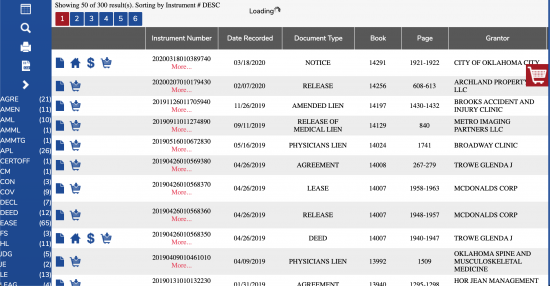Updated April 12, 2024
An Oklahoma deed is a legal form that can be used to transfer interests in real property, or land and buildings, from one owner to another. Deeds are required to list the seller (grantor) and the buyer (grantee), legal description of the property, and a notary acknowledgment. There are different types of deeds depending on the purpose and use of the document. A general warranty and special warranty include a warranty of the grantor to the grantee. A quit claim comes with no such warranty and is used in specific circumstances where such a warranty is not needed. In order to determine exactly what interest the purchaser in buying, it is important to have a title (property) search completed prior to the closing.
Laws – Title 16 (Conveyances)
Recording – All deeds are to be filed in the respective County Clerk’s Office where the property is located.[1]
Signing – All deeds that are to be recorded in the State of Oklahoma are required to be acknowledged in the presence of a notary public.[2]
Deed Types (4)
 General Warranty – Comes with a warranty from the grantor that the property they are selling is free and clear of any claims.
General Warranty – Comes with a warranty from the grantor that the property they are selling is free and clear of any claims.
Download: PDF, MS Word, Open Document
 Quit Claim – Does not include a warranty. The seller is just releasing whatever claim they may (or may not) have to the property.
Quit Claim – Does not include a warranty. The seller is just releasing whatever claim they may (or may not) have to the property.
Download: PDF, MS Word, Open Document
 Special Warranty – Comes with a limited warranty. The grantor only warrants the title for the time they owned the property but not prior.
Special Warranty – Comes with a limited warranty. The grantor only warrants the title for the time they owned the property but not prior.
Download: PDF, MS Word, Open Document
 Transfer on Death – Conveys ownership of real property without probate.
Transfer on Death – Conveys ownership of real property without probate.
Download: PDF, MS Word, Open Document
Oklahoma Property Search (6 steps)
In Oklahoma, property records are kept at the Registrar of Deeds at the County Clerk’s Office. When purchasing property and you want to be sure what you are buying, it is important to have a title search completed. Some counties have online searching. Below is an example of how to start an online search on Oklahoma County:
Step 1
Go to the Registrar of Deeds site.

Step 2
Read the disclosure and then click on “OKCC.ONLINE.”

Step 3
Select the “ROD” button to proceed with the search.

Step 4
Enter the name of the grantor in the first available field. You will then want to use the remaining filters to narrow your search. You are looking for the deed that transferred the property to the grantor originally, in other words, when the grantor was the grantee. Select “Search” to proceed.

Step 5
Once you have found the deed you are looking for, you are going to check it to make sure the description of the property is the same. In addition, you are going to need the name of the grantor on that deed to search as the grantee. You will continue in this manner until you have gone back fifty years and have determined that each deed properly lists the property. You will want to make a copy of each deed.

Step 6
The next step is to search “forward” starting with the grantor of the first deed from 50 years ago and do a search on each grantor going forward to determine whether he or she granted interests to the property, such as easements or mortgages and make sure such granted interests are resolved and taken account of. The most up-to-date information will be held at the registrar’s office.
